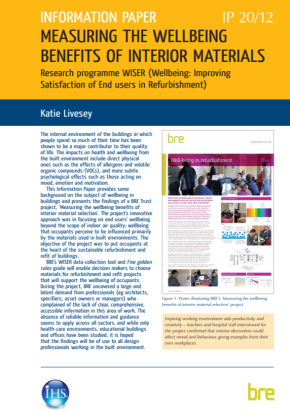Measuring the wellbeing benefits of interior materials
Measuring the wellbeing benefits of interior materials: Research programme WISER (Wellbeing: Improving Satisfaction of End users in Refurbishment (IP 20/12) was written by K Livesey and published by BRE on 13 August 2012.
The internal environment of buildings has been shown to be a major contributor to the quality of life of occupants. Health and wellbeing is affected both by direct physical impacts, such as the effects of allergens and volatile organic compounds (VOCs), and more subtle psychological effects such as those acting on mood, emotion and motivation.
This 12-page Information Paper offers an introduction to wellbeing in buildings and presents the findings of a BRE Trust project, ‘Measuring the wellbeing benefits of interior material selection’, which focussed on end users’ wellbeing beyond the scope of indoor air quality.
The objective of the project was to put occupants at the heart of the sustainable refurbishment and refit of buildings. BRE's WISER data-collection tool and Five golden rules guide enable decision makers to choose materials for refurbishment and refit projects that support the wellbeing of occupants. During the project, BRE uncovered a demand from built environment professionals, who complained there was a lack of clear, comprehensive, accessible information in this area.
You can download the Information Paper at: https://www.brebookshop.com/details.jsp?id=327000
[edit] Related articles on Designing Buildings Wiki
- 2019 Wellness and biophilia symposium.
- All about wellness.
- Assessing health and wellbeing in buildings.
- BRE articles.
- BRE wellbeing research paper competition.
- BREEAM.
- Building related illness.
- Building Research Establishment.
- TG10 2016 At a glance, wellbeing.
- Thermal comfort and wellbeing.
- WELL and BREEAM align.
- WELL Building Standard.
- Wellbeing.
- Wellbeing and creativity in workplace design - case studies.
- Wellbeing considerations for property managers.
- What we know about wellbeing.
Featured articles and news
Latest Build UK Building Safety Regime explainer published
Key elements in one short, now updated document.
UKGBC launch the UK Climate Resilience Roadmap
First guidance of its kind on direct climate impacts for the built environment and how it can adapt.
CLC Health, Safety and Wellbeing Strategy 2025
Launched by the Minister for Industry to look at fatalities on site, improving mental health and other issues.
One of the most impressive Victorian architects. Book review.
Common Assessment Standard now with building safety
New CAS update now includes mandatory building safety questions.
RTPI leader to become new CIOB Chief Executive Officer
Dr Victoria Hills MRTPI, FICE to take over after Caroline Gumble’s departure.
Social and affordable housing, a long term plan for delivery
The “Delivering a Decade of Renewal for Social and Affordable Housing” strategy sets out future path.
A change to adoptive architecture
Effects of global weather warming on architectural detailing, material choice and human interaction.
The proposed publicly owned and backed subsidiary of Homes England, to facilitate new homes.
How big is the problem and what can we do to mitigate the effects?
Overheating guidance and tools for building designers
A number of cool guides to help with the heat.
The UK's Modern Industrial Strategy: A 10 year plan
Previous consultation criticism, current key elements and general support with some persisting reservations.
Building Safety Regulator reforms
New roles, new staff and a new fast track service pave the way for a single construction regulator.
Architectural Technologist CPDs and Communications
CIAT CPD… and how you can do it!
Cooling centres and cool spaces
Managing extreme heat in cities by directing the public to places for heat stress relief and water sources.
Winter gardens: A brief history and warm variations
Extending the season with glass in different forms and terms.
Restoring Great Yarmouth's Winter Gardens
Transforming one of the least sustainable constructions imaginable.
























